We’ve all experienced that unmistakable sound that cuts through the air like a sonic boom – the thunderous blast of a train horn. Whether you’re waiting at a railroad crossing or simply curious about these powerful acoustic warnings, you’ve probably wondered just how loud these mechanical giants really are.
Train horns pack an incredible acoustic punch that’s specifically engineered to grab attention and save lives. These aren’t your average car horns – they’re sophisticated safety devices designed to cut through ambient noise and alert everyone within a important radius of an approaching locomotive.
Understanding train horn decibel levels isn’t just trivia for railroad enthusiasts. It’s essential knowledge for anyone living near tracks, working in transportation, or simply wanting to protect their hearing when trains pass by. We’ll explore the fascinating science behind these powerful warning systems and reveal exactly what makes them so remarkably loud.
How Loud Is a Train Horn: Decibel Measurements
Train horns produce between 110 and 175 decibels at their source depending on the exact type and manufacturer. Federal Railroad Administration regulations require train horns to emit at least 96 decibels and no more than 110 decibels when measured 100 feet from the locomotive under standardized testing conditions.
Most freight train horns generate approximately 130 to 150 decibels at a distance of 3 feet from the horn’s opening. Passenger trains typically operate with slightly quieter horns that range from 110 to 130 decibels at the same measurement distance. High speed rail systems often use horns calibrated to 120 decibels to balance safety requirements with noise ordinances in populated areas.
Comparison with Common Sounds
Understanding train horn decibel levels becomes clearer when we compare them to familiar everyday sounds:
| Sound Source | Decibel Level | Distance |
|---|---|---|
| Train horn | 110-175 dB | At source |
| Jet engine | 130-140 dB | 100 feet |
| Rock concert | 115 dB | Front row |
| Motorcycle | 95 dB | 25 feet |
| Lawnmower | 90 dB | Operator position |
| Normal conversation | 60 dB | 3 feet |
Distance and Decibel Reduction
Sound intensity decreases by approximately 6 decibels for every doubling of distance from the source. A train horn measuring 130 decibels at 10 feet drops to 124 decibels at 20 feet and 118 decibels at 40 feet. Environmental factors including humidity, wind direction, and temperature affect these measurements significantly.
Urban environments with buildings and obstacles can reduce train horn volume by 10 to 15 decibels through sound absorption and deflection. Rural areas with fewer obstructions allow train horns to travel farther while maintaining higher decibel levels. Weather conditions such as fog or rain can either amplify or dampen train horn sounds by up to 5 decibels.
Regulatory Standards
The Federal Railroad Administration mandates exact decibel ranges for different train operations and geographic locations. Quiet zones require trains to maintain horn volumes below 96 decibels when measured at the nearest residential property line. Emergency situations allow engineers to exceed standard decibel limits when immediate danger exists.
Local municipalities can petition for additional noise restrictions that further limit train horn volumes during nighttime hours between 10 PM and 6 AM. These ordinances typically reduce maximum allowable decibel levels by 5 to 10 decibels compared to daytime operations.
Federal Railroad Administration Sound Requirements
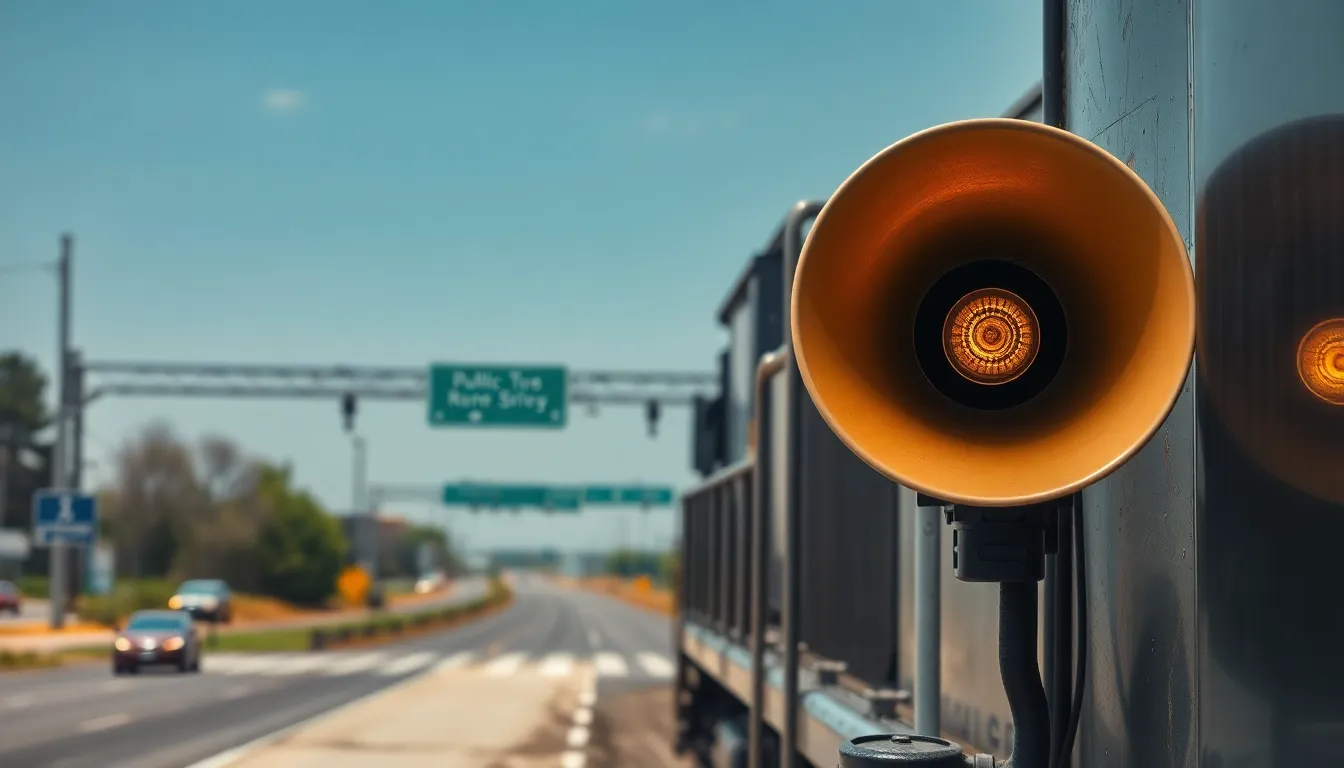
Federal Railroad Administration regulations establish exact acoustic standards that train operators must follow when approaching public highway crossings. These requirements ensure consistent safety protocols across all rail systems operating in the United States.
Minimum Sound Level Standards
Train horns must produce a minimum of 96 decibels when measured at 100 feet from the locomotive according to 49 CFR 229.129. This baseline ensures horns remain audible above ambient traffic noise and environmental sounds that commonly occur near railroad crossings.
The maximum permitted sound level reaches 110 decibels at the same 100-foot measurement distance. Engineers must maintain horn output within this 96 to 110 decibel range to comply with federal safety standards while avoiding excessive noise pollution in surrounding communities.
Horn activation follows a mandatory pattern consisting of two long blasts followed by one short blast and one final long blast. Operators repeat or prolong this sequence until the locomotive completely enters the crossing area.
Maximum Distance Requirements
Locomotive engineers activate warning horns at least 15 seconds before entering any public crossing but cannot exceed 20 seconds of advance warning. This timing requirement balances adequate notification with noise reduction for nearby residents.
Distance restrictions limit horn activation to no more than one quarter mile before reaching the nearest crossing point. Engineers must honor this quarter mile maximum even when it results in less than the standard 15 second warning period.
Federal preemption supersedes any conflicting state or local ordinances about train horn usage at public crossings. Local communities can establish quiet zones through exact FRA procedures but cannot independently modify these core timing and distance requirements.
Types of Train Horns and Their Sound Levels
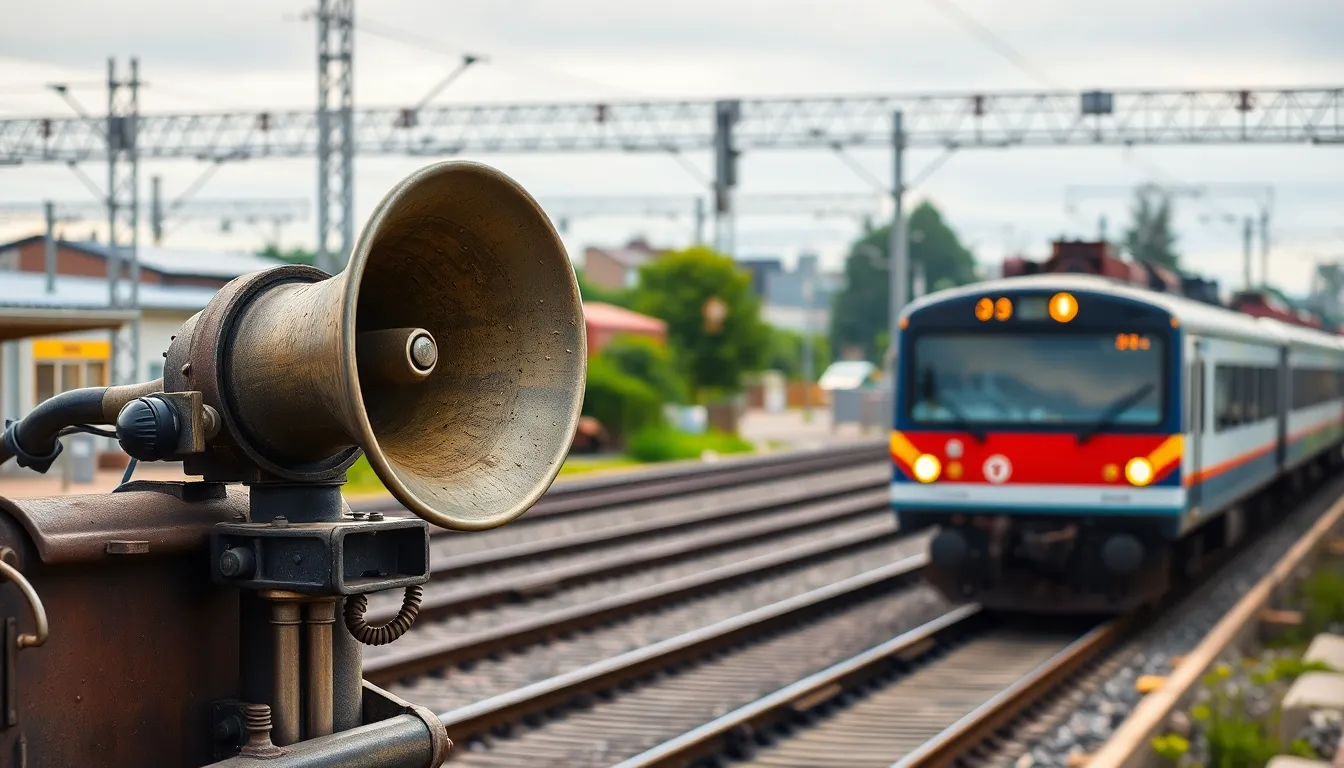
Different train systems use varying horn designs that produce distinct sound levels based on their operational requirements. We’ll examine the exact decibel ranges and regulatory standards for each major category of train horns.
Freight Train Horns
Freight train horns generate some of the loudest warning signals in rail transportation. These horns produce sound levels ranging from 110 to 150 decibels when measured at 100 feet from the locomotive. Federal Railroad Administration regulations mandate that freight train horns emit a minimum of 96 dB and cannot exceed 110 dB at the standard measurement distance. The powerful acoustic output ensures these warnings cut through ambient noise in industrial areas and busy freight corridors where multiple trains operate simultaneously.
Passenger Train Horns
Passenger train horns operate within similar sound parameters as their freight counterparts. Sound levels for passenger trains typically range from 110 to 140 decibels at 100 feet. The same FRA regulations apply to passenger operations, requiring minimum output of 96 dB while capping maximum levels at 110 dB. Passenger train horns balance safety requirements with consideration for populated areas where these trains frequently travel through urban and suburban environments.
Light Rail and Subway Horns
Light rail and subway systems employ quieter horn designs due to their urban operating environments. These horns produce significantly lower decibel levels compared to freight and passenger trains, though exact measurements aren’t widely documented. Local noise ordinances typically govern these systems rather than federal regulations, ensuring horns remain audible for safety while minimizing disruption in densely populated areas. Municipal authorities often set custom sound limits that balance pedestrian safety with community noise concerns.
Factors That Affect Train Horn Volume
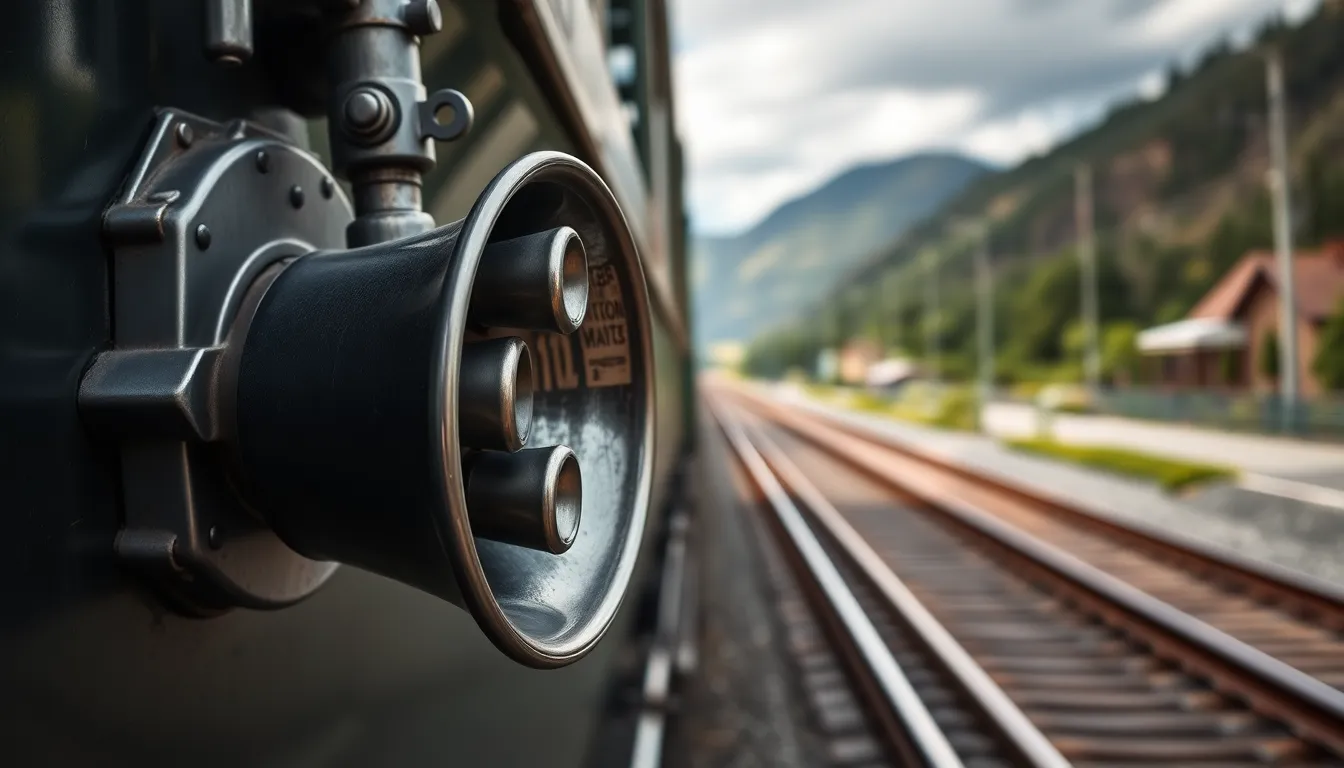
Several key elements influence how loud train horns sound when they reach our ears. These factors determine whether we hear the full intensity of the horn or experience reduced volume levels.
Environmental Conditions
Weather conditions dramatically alter how train horn sounds travel through the atmosphere. Fog and rain absorb sound waves, reducing the effective range and perceived volume of train horns by up to 10-15 decibels compared to clear conditions. Temperature inversions create acoustic channels that can carry train horn sounds much farther than normal, sometimes extending audibility by several miles beyond typical ranges.
Atmospheric pressure changes affect sound wave propagation, with high pressure systems allowing clearer transmission of train horn frequencies. Terrain features like hills, valleys, and buildings create sound shadows and reflection patterns that can either amplify or diminish horn volume depending on our location relative to the train. Wind direction and speed also play crucial roles, as tailwinds can carry sounds farther while headwinds compress and reduce acoustic range.
Horn Design and Maintenance
Horn configuration directly impacts the decibel output we experience from train horns. Multiple horn arrangements, such as five-chime or three-chime systems, produce different sound patterns and volume levels, with some configurations reaching the upper limits of the 110-150 decibel range at 100 feet. Horn size and internal chamber design determine the fundamental frequency and amplitude of the sound waves generated.
Maintenance status significantly affects train horn performance and volume consistency. Clean horns without debris or corrosion maintain optimal acoustic output, while dirty or damaged horns can reduce sound levels below the required 96 decibel minimum at 100 feet. Worn diaphragms, clogged air passages, and damaged mounting hardware cause irregular sound patterns and decreased volume output that compromise safety effectiveness.
Regular inspection schedules ensure horns meet FRA compliance standards for both minimum and maximum decibel requirements. Properly maintained horns deliver consistent sound levels within the regulatory 96-110 decibel range, while neglected equipment may produce unpredictable volume variations that affect warning capabilities.
Health and Safety Implications of Train Horn Noise

Train horn noise creates important health concerns and community challenges that extend far beyond their primary safety function. Understanding these implications helps us recognize the complex balance between railroad safety requirements and public welfare.
Hearing Damage Risks
Prolonged exposure to sounds above 85 dB causes permanent hearing damage according to medical research. Train horns producing 110 to 150 dB at 100 feet present immediate risks to anyone within close proximity of operating locomotives. Railroad workers face the highest exposure levels, experiencing sound intensities that can reach 140 dB or higher during routine operations.
Sound waves at these extreme levels damage delicate ear structures instantly without proper protection. Repeated exposure compounds this damage, leading to noise-induced hearing loss that affects millions of transportation workers annually. Even brief encounters with train horns at distances under 50 feet can cause temporary hearing threshold shifts lasting several hours.
Protection becomes critical for anyone regularly exposed to these sound levels. Standard hearing protection reduces exposure by 15 to 30 dB, making train horn encounters safer for workers and nearby residents. Emergency responders and maintenance crews require specialized equipment rated for extreme noise environments to prevent occupational hearing loss.
Community Noise Impact
Train horn noise disrupts residential areas through both volume and frequency of activation patterns. The Federal Railroad Administration requires minimum sound levels of 96 dB and maximum levels of 110 dB measured at 100 feet to balance safety with noise control efforts.
Communities near rail crossings experience multiple horn activations daily, with each sequence lasting 15 to 20 seconds per crossing approach. Urban areas report hundreds of these events during peak traffic periods, creating cumulative noise exposure that affects sleep patterns and quality of life measurements.
Quiet zones offer relief by implementing alternative safety measures that reduce horn usage requirements. These designated areas use enhanced crossing signals, improved visibility measures, and additional warning systems to maintain safety while minimizing acoustic disruption. Currently, over 2,400 quiet zones operate across the United States, protecting residential communities from routine train horn noise.
Property values in areas with frequent train horn exposure show measurable decreases compared to similar locations without rail noise. Studies indicate reductions ranging from 3% to 8% for homes within 1,000 feet of active crossings, demonstrating the economic impact of transportation noise on community development.
Train Horn Quiet Zones and Regulations
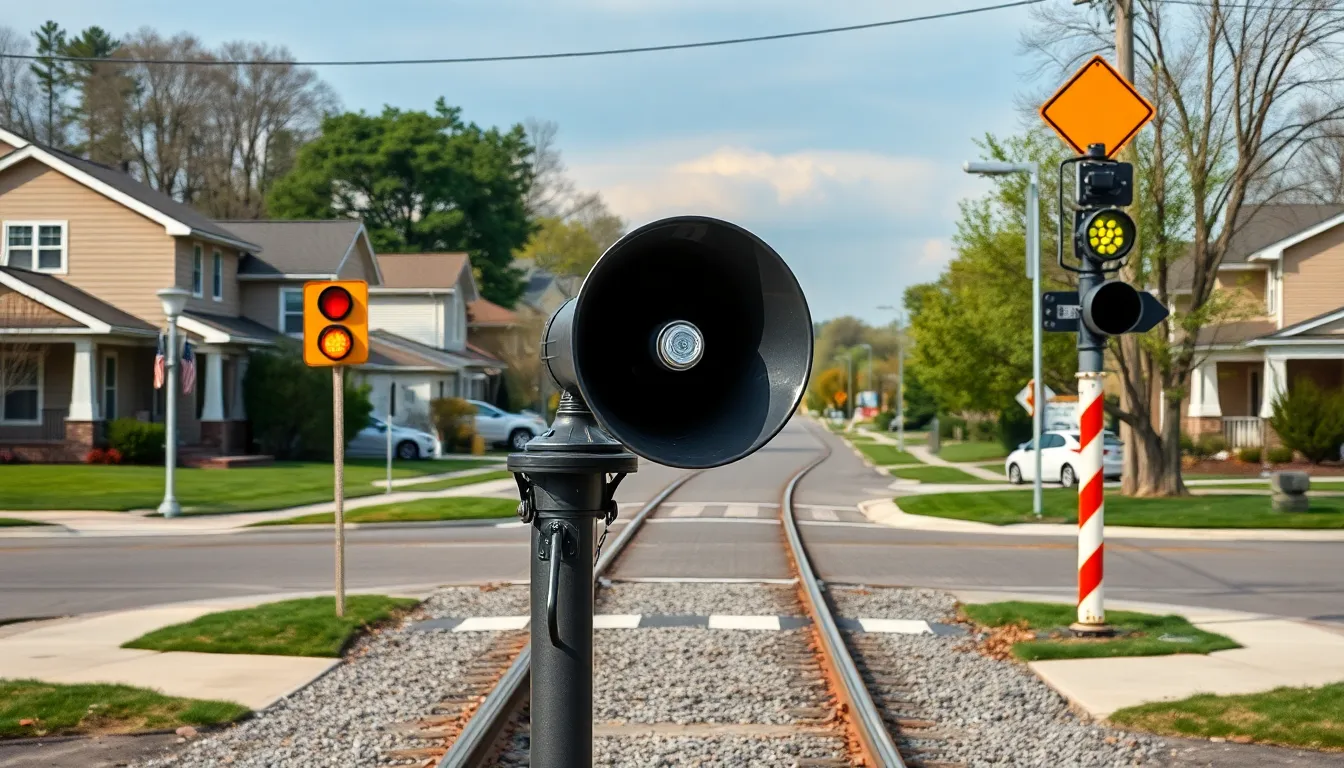
Train horn quiet zones represent designated areas where locomotive operators restrict horn use to reduce noise disturbance in residential communities. The Federal Railroad Administration establishes exact procedures for communities seeking to carry out these zones while maintaining crossing safety standards. Currently, over 2,400 quiet zones operate across the United States, demonstrating the widespread adoption of this noise mitigation strategy.
Communities must carry out supplemental safety measures before establishing quiet zones, including upgraded crossing signals, medians, or four-quadrant gate systems. These alternative warning devices compensate for the reduced acoustic alerts, ensuring pedestrian and vehicle safety remains uncompromised. Local governments work directly with railroad companies to assess crossing conditions and determine appropriate safety enhancements for each location.
The FRA maintains strict oversight of quiet zone operations through regular safety evaluations and incident monitoring. Railroad operators retain the authority to sound horns in emergency situations, even within established quiet zones, when immediate danger threatens public safety. Emergency horn use includes situations involving trespassers on tracks, equipment malfunctions, or unexpected obstacles requiring immediate warning signals.
Federal regulations specify that train horns must operate between 96 and 110 decibels when measured at 100 feet from the locomotive, regardless of quiet zone status. This standardized volume range ensures consistent safety performance across all railroad operations while providing communities with predictable noise level expectations. Operators follow prescribed horn patterns consisting of two long blasts, one short blast, and one long blast, repeated until trains completely clear public crossings.
Quiet zone applications require comprehensive safety assessments documenting existing crossing conditions, traffic patterns, and proposed safety improvements. The FRA reviews each application for compliance with federal safety standards before approving quiet zone establishment. Communities must demonstrate that alternative safety measures provide equivalent protection levels compared to standard horn warnings for approval consideration.
Railroad companies coordinate with local authorities to establish quiet zone boundaries and operational procedures exact to each designated area. These collaborations ensure that train crews understand zone locations and applicable restrictions while maintaining operational efficiency. Documentation requirements include detailed mapping, safety measure specifications, and ongoing maintenance responsibilities for all parties involved in quiet zone operations.
How Train Horn Volume Compares to Other Sounds
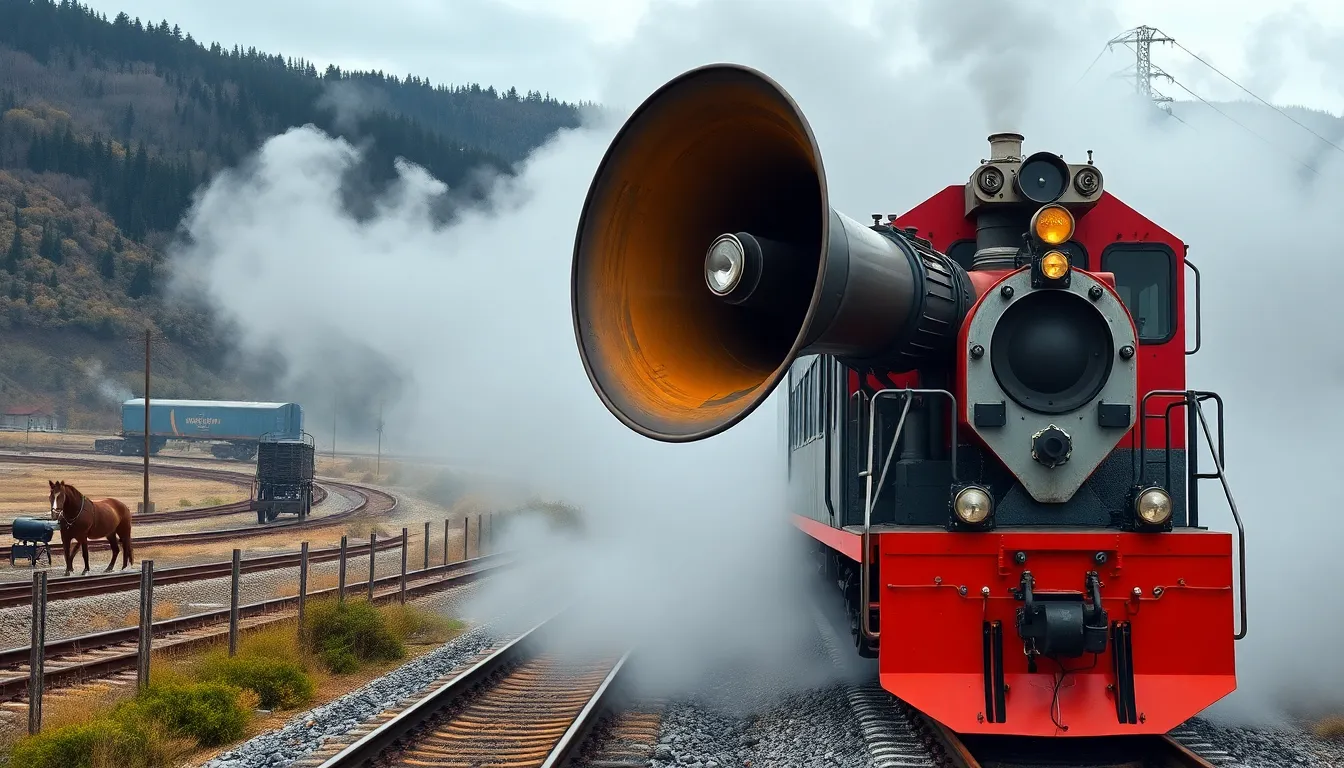
Train horns generate sound levels between 110 and 150 decibels when measured at 100 feet, making them significantly louder than most sounds we encounter daily. Understanding these volume comparisons helps us appreciate the remarkable intensity of locomotive warning systems and their effectiveness at cutting through background noise.
Everyday Sound Comparisons
| Sound Source | Decibel Level (dB) |
|---|---|
| Normal conversation | 60 |
| Lawnmower | 90 |
| Motorcycle | 100 |
| Train horn | 110-150 |
| Rock concert | 120+ |
Comparing train horns to familiar sounds reveals their extraordinary volume. A typical conversation between two people produces approximately 60 decibels, while train horns exceed this by 50 to 90 decibels. Lawnmowers generate around 90 decibels, making train horns roughly 20 to 60 decibels louder than this common yard equipment.
Motorcycles typically produce 100 decibels, yet train horns still surpass them by 10 to 50 decibels. Rock concerts often exceed 120 decibels, placing train horns in a similar intensity range as live music performances in large venues.
Horn Type Volume Variations
Electric train horns operate at approximately 120 decibels due to their lower air pressure systems. Air horns range from 110 to 145.8 decibels, depending on their exact design and pressure capabilities. Traditional train horns can reach up to 150 decibels, utilizing lower pitch sound waves that travel farther distances than higher frequency alternatives.
The Federal Railroad Administration mandates minimum sound levels of 96 decibels measured at exact track points to ensure adequate warning capability. Maximum allowable levels reach 110 decibels at 100 feet from locomotives, establishing clear operational boundaries for safety compliance.
Distance and Sound Intensity
Sound intensity decreases as distance from the source increases, affecting how we perceive train horn volume. At 3 feet from freight locomotives, sound levels typically measure 130 to 150 decibels. Moving to 100 feet reduces these levels to the regulated 110 to 150 decibel range, demonstrating important volume reduction over relatively short distances.
Environmental factors further influence perceived loudness, with fog and rain absorbing sound waves and reducing volume by 10 to 15 decibels. Temperature inversions can carry train horn sounds farther than normal conditions, creating unexpected volume variations in different weather patterns.
Conclusion
Understanding train horn decibel levels helps us make informed decisions about hearing protection and residential choices near railway corridors. We’ve seen how these powerful warning systems balance critical safety requirements with community noise concerns through federal regulations and local initiatives.
The impressive range of 110-175 decibels at the source demonstrates why train horns remain one of our most effective transportation safety tools. Whether you’re a railroad worker needing proper hearing protection or a homeowner considering property near tracks we hope this information helps you navigate the acoustic realities of train operations.
As communities continue developing quiet zones and implementing supplemental safety measures we’re finding better ways to coexist with these essential transportation networks while protecting both our hearing and our quality of life.
Frequently Asked Questions
How loud are train horns in decibels?
Train horns produce between 110 and 175 decibels at their source, depending on the type and manufacturer. Federal regulations require them to emit at least 96 decibels when measured 100 feet from the locomotive. Most freight train horns generate approximately 130 to 150 decibels at a distance of 3 feet, while passenger trains typically operate with slightly quieter horns ranging from 110 to 130 decibels.
What are the federal requirements for train horn volume?
The Federal Railroad Administration (FRA) requires train horns to produce a minimum of 96 decibels and a maximum of 110 decibels when measured at 100 feet from the locomotive. Train horns must be activated at least 15 seconds before reaching a crossing, but not more than 20 seconds in advance, and must be limited to activation within a quarter mile of the crossing.
How do train horns compare to other loud sounds?
Train horns are significantly louder than everyday sounds. A normal conversation is about 60 decibels, while train horns exceed this by 50 to 90 decibels. They’re comparable to jet engines and rock concerts in intensity, making them much louder than lawnmowers, motorcycles, and other common noise sources we encounter daily.
What factors affect how loud train horns sound?
Environmental conditions significantly impact train horn volume. Weather factors like fog and rain can absorb sound waves, reducing volume by up to 10-15 decibels. Temperature inversions can carry sounds farther than normal. Horn design, maintenance condition, and distance from the source also play crucial roles in determining the perceived loudness.
Can train horn noise cause hearing damage?
Yes, prolonged exposure to train horn noise can cause hearing damage. Railroad workers are particularly vulnerable, facing sound intensities that can exceed 140 dB during operations. The high decibel levels produced by train horns make hearing protection essential for anyone regularly exposed to these sounds, especially those working in the transportation industry.
What are train horn quiet zones?
Train horn quiet zones are designated areas where locomotive operators restrict horn use to reduce noise disturbance in residential communities. Before establishing these zones, communities must implement supplemental safety measures like upgraded crossing signals or gate systems. The FRA oversees these zones through regular safety evaluations, and operators can still sound horns in emergencies.
Do different types of trains have different horn volumes?
Yes, different train types produce varying horn volumes. Freight train horns generate some of the loudest signals at 110-150 decibels at 100 feet. Passenger train horns typically range from 110-140 decibels. Light rail and subway systems use quieter horn designs, governed more by local noise ordinances than federal regulations to minimize disruption in urban areas.
How does distance affect train horn volume?
Sound intensity decreases significantly with distance from the source. While train horns may produce 130-150 decibels at 3 feet, this volume drops considerably as you move farther away. Federal measurements are standardized at 100 feet from the locomotive, where horns must produce between 96-110 decibels to meet regulatory requirements.

